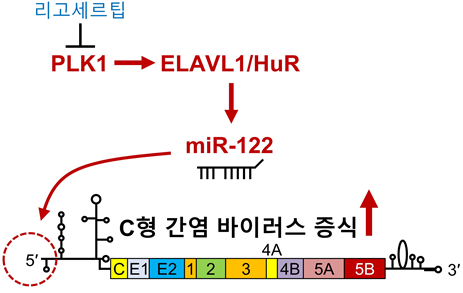Researchers in Korea have found a new way to suppress the growth of the hepatitis C virus.
A group of researchers led by Professor Kim Jong-heon at the National Cancer Center (NCC) said Wednesday they have identified a key mechanism for the proliferation of the hepatitis C viruses.
If hepatitis C, mainly infected through blood, leads to chronic hepatitis, it is highly likely to develop liver cirrhosis or liver cancer. Unfortunately, no vaccine has been developed so far, although there are about 100 million hepatitis C patients worldwide.
The research team has identified the mechanism of polo-like kinase 1 (PLK1)-embryonic lethal and abnormal vision gene/human antigen R (ELAVL1 HuR), which plays a key role in the virus proliferation.

MiR-122 is a 22 sequence of microRNAs expressed only in the liver. MicroRNA, a small piece of RNA in 21 to 23 sequences, differs from conventional RNA. It mainly controls protein expression by combining with mRNA. MiR-122 binds to the five-prime end of the hepatitis C virus RNA to stabilize the viral RNA. It amplifies protein expression to help virus proliferation.
By identifying the signaling mechanism that regulates miR-122, the research team has also discovered “rigosertib,” an antiviral new drug candidate that controls this. Rigosertib inhibits the phosphorylase function of PLK1 in the cell, and impedes the PLK1 sub-signaling process (ELAVL1/HuR-miR-122), thus inhibiting the growth of the hepatitis C virus, the research team explained.
The research team confirmed the antiviral efficacy of rigosertib through liver cancer cell lines and animal experiments. It is conducting phase 3 clinical trials for the new anticancer drug substance. It has also completed the patent registration process for a light-emitting sensor system capable of sensitively detecting hepatitis C virus proliferation and miR-122 regulation simultaneously and is conducting further research for basic research, new drug development, and discovery.
“We expect the new drug candidate, rigosertib, discovered in connection with miR-122, to become a candidate for a new type of treatment, which inhibits the growth of hepatitis C virus closely related to liver cancer in the future,” Professor Kim said. “Rigosertib discovered through this study will be an alternative to overcome RNA virus mutation resistance, the Achilles' heel of the blockbuster new drug, Sovaldi (sofosbuvir) developed by Gilead Science.”
Seo Yoo-na, a researcher at the Department of the Cancer Molecular Biological Research at NCC, Dr. Park Jong-bae, head of the Industry-Academic Cooperation Corps. at the NCC’s Graduate School of Cancer Science and Policy in NCC, and Cho Sung-chan, a senior fellow at the Korea Research Institute of Bioscience and Biotechnology, also participated in the research.
Their study was published in the latest issue of the Proceedings of the National Academy of Sciences (PNAS).

